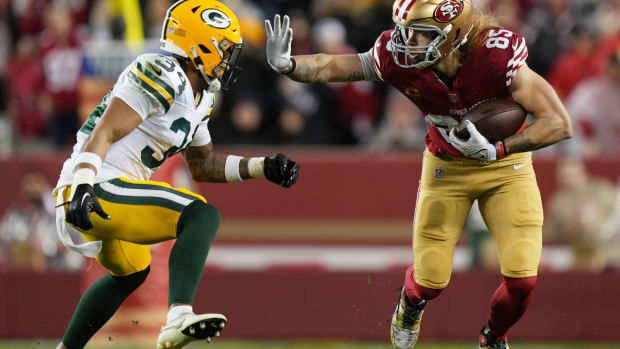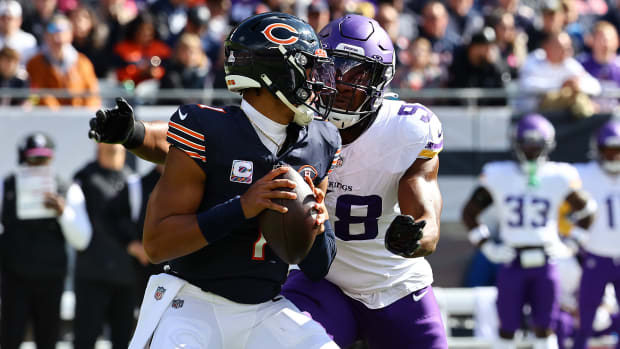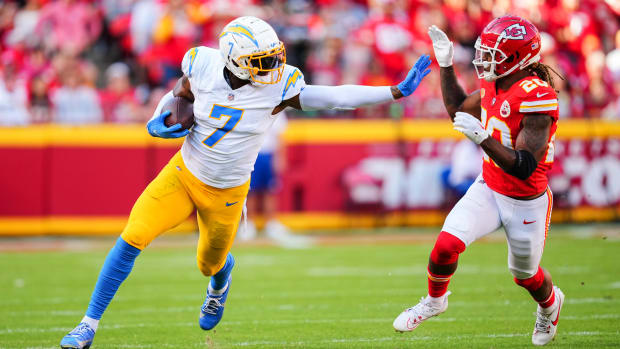What Another .500 Season Taught the Chicago Bears
It's easy to look at a second straight 8-8 season and a playoff loss and see the Bears spinning their wheels.
This is because they did.
Yet, even in this stagnation they produced positives potentially valuable as they move into 2021.
Remember, as wide receiver Muhsin Muhammad once said, "Amid all the ashes and rubble, a flower bloomed today."
The Bears weren't quite ashes and rubble in 2020. They were more like a dilapidated structure pleading for renovation.
They just need someone to rehab emphasizing the positives.
1. Discovery of the Running Game
It wasn't just David Montgomery being an effective runner. They already knew this from all the tacklers who missed chances to bring him down during his rookie season.
This was more about being able to blend together the right blockers and scheme with the back.
Once they had the bootleg-style of offense to go with a different offensive line, they were able to establish running lanes easier.
Getting enough good play from Sam Mustipher at center to put Cody Whitehair at guard, with Alex Bars at right guard, provided the right manpower. The bootleg action and movement of quarterback Mitchell Trubisky stretched the defensive front across the line of scrimmage and further created openings.
It didn't work at all in the playoff game and there has to be concern they can actually play this way successfully for a full season against stronger teams. They'll play enough of those next year, considering they have the third-toughest schedule based on opposing win percentage.
They'll need to take this, expand it and learn why it didn't work as well against Green Bay in the season finale, then failed against the Saints.
It might be a style they choose to blend in with something else in the future to keep defenses more off balance.
What's even more encouraging is they were able to run up the middle, something they've been largely unable to do for almost a quarter century. They finished 17th in rushing average up the middle, at 4.3 yards an attempt. Considering they've only been higher than that one other time in the last 22 years, that's an achievement in and of itself.
2. Coaching Adaptability
A coach can't be entirely inflexible. Circumstances sometimes force improvisation. Matt Nagy received plenty of criticism for this in 2019 when he wouldn't use more plays from under center with Mitchell Trubisky after it became apparent he worked better this way. Saddled with a struggling running game and with the passing attack choked off as a direct result, Nagy and offensive coordinator Bill Lazor adapted the running attack and then they showed they could actually stick to the run when required during the course of games. If there was anything to be garnered from their big win at Minnesota, it was a willingness to commit to the run. For someone like Nagy, who came from the pass-first and pass-always style of Andy Reid, this truly was swallowing your ego. Also involved in this was how Nagy was willing step away from play calling and let Lazor handle it. It showed he could delegate authority.
3. Between the Uprights, Not Off Them
The Cody Parkey incident and aftershock, then Eddy Pineiro's up-and-down 2019 season made it seem Nagy and GM Ryan Pace didn't know the first thing about the kicking game. They were the laughing stock of the offseason leading up to 2019 as a result. The solution wound up being a kicker Nagy had great familiarity with from their time together in Kansas City, Cairo Santos. Nagy said from the outset he didn't want to settle for field goals. At least if you have a kicker, you know when you do settle for trying them at least you'll get them.
4. Pressure Cooks
In this case, a negative reinforced what they need to be better at doing on defense. It was like a refresher course because they did it in 2019 and apparently didn't learn from it. After 2018, it seemed apparent how great an impact their pass rush could have on the secondary's coverage. The 27 interceptions went hand in hand with 50 sacks. It was the third-most sacks in the league. Yet, there are many who feel in today's game pass coverage is far more important. The Bears found out in 2019 what happens when you combine a struggling pass rush with a capable secondary. They had tied a club record low of eight interceptions for the third time in four years. So they went out and brought in Robert Quinn instead of Leonard Floyd to provide pass rush pressure. He didn't. All they did was accomplish the same thing as the pass rush struggled again and they produced 35 sacks, 17th in the league. They had 10 interceptions, tied for 23rd. They need more of each and actually getting the pass rush pressure and sacks next season will be critical in piling up interceptions. With changes on the defensive coaching staff, some of this could start to surface in play next year.
5. The Binding
Coaches love falling back on cliches and talking about how overcoming adversity binds a team. If this is the case, then the players who remain from this team for next season carry with them a huge sense of unity. They were 5-7 and on the edge of the cliff but fought back to get in the playoffs, and then trailed just 7-3 in the third quarter against the second seed in the NFC on the road. All the wheels came off then, and it's legitimate to question whether they really accomplished much with three straight wins against weaker defenses. Yet, during the six-game losing streak they didn't appear capable of even beating the bad teams and they finally figured out how to do this. The next step is beating better teams. No one ever did question the unity of this team before the losing streak, and in it's aftermath they've cemented this feeling of being able to fight through anything.
Twitter: BearDigest@BearsOnMaven




